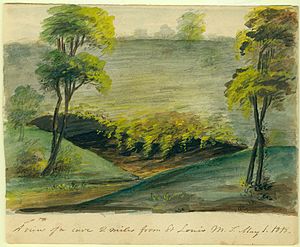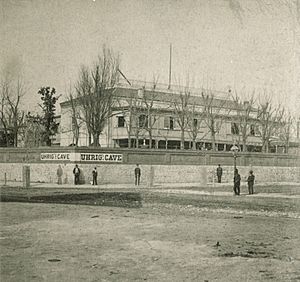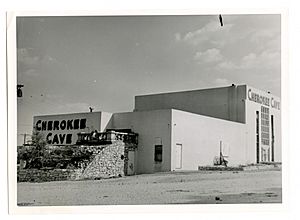Caves of St. Louis facts for kids
The Caves of St. Louis are natural underground spaces that have played a big part in the history of St. Louis, Missouri. The city was actually built on top of a large network of these caves. Long ago, before people had modern refrigerators, these naturally cool caves were perfect for storing things. Early German immigrants found them especially useful for making and storing a drink called beer.
Contents
Cool Caves for Breweries
Many businesses that made drinks were built right on top of these natural caves. Workers changed the caves to make them even better for their needs. They added strong stone arches and brick ceilings to stop water from leaking in. They also paved the uneven cave floors with bricks.
These cool, underground spaces were not just for storage. Sometimes, they were used as fun gathering spots, like entertainment areas.
One important person was John Adam Lemp. He came to St. Louis from Germany in 1838. He started a business that used the natural caves to keep things cold. Later, his son, William J. Lemp, took over. He built a large factory complex called the Lemp Brewery, which you can still see in St. Louis today. The Lemp family also built a large house called the Lemp Mansion. This house even had a secret tunnel that went through the cave system all the way to the brewery! The Lemp family used this tunnel to get to work.
Caves and the Underground Railroad
There is a special story passed down through generations in St. Louis about the cave system. This story connects the caves to the Underground Railroad. The Underground Railroad was a secret network that helped enslaved people find freedom.
According to this story, a hidden tunnel behind a house at 3314 Lemp Avenue was used as a secret way into the caves. One entrance to the caves is very close to the Mississippi River. This location would have allowed enslaved people to reach the river and continue their journey to freedom.
Cherokee Caves Attraction
The Cherokee Caves were once an attempt to turn some of the caves near the Lemp Brewery into a tourist attraction. However, these caves were later closed. The area was then taken down to make space for the building of a major highway called Interstate 55.
In January 2019, a group called the Missouri Speleological Survey published a detailed history about the Lemp Brewery Caverns and Cherokee Cave.
Cave Entrances Today
Many old caves were filled up with rocks and dirt when buildings above them were torn down. This means that many homes and buildings today might be sitting on top of old cave entrances that are now buried.
The Lemp caves, also known as the Cherokee caves, still exist underground. The original cave system was very long, about 24,000 feet (over 7 kilometers) that people could walk through. After Interstate 55 was built, about 22,000 feet (over 6.7 kilometers) of the cave remained. However, these parts of the cave are not open for the public to visit.
- The Lost Caves of St. Louis
- Caves of Missouri




